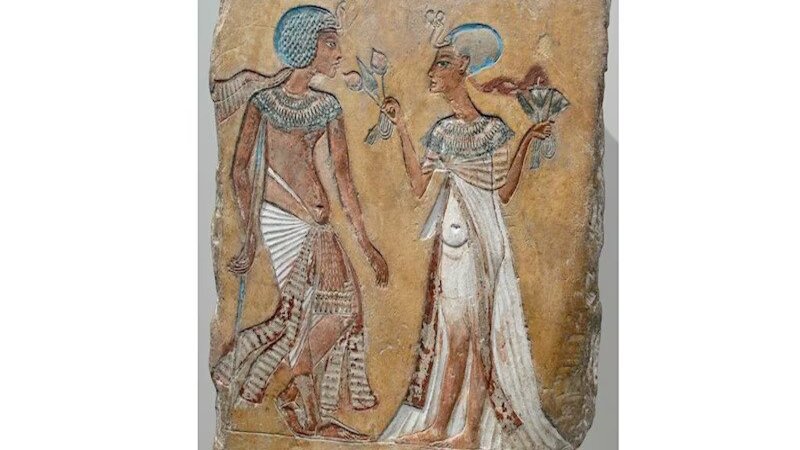Tutankhamun’s Wardrobe with Dr Gillian Vogelsang-Eastwood
Tue, Oct 18, 2022 7:00 PM - 8:30 PM British Summer Time (UTC+1)
Tickets (£5.98) here.
Talk on the Garments from the Tomb of the Egyptian Pharoh Tutankhamun by the Director of the Textile Research Centre in Leiden
About this event
Howard Carter’s discovery of the Egyptian king Tutankhamun’s tomb in 1922 caused an international sensation. The tomb of the boy king was prepared for his afterlife with an astonishing array of items that captured the world’s attention – including the famous gold and lapis mask. Lesser known is his wardrobe of 3,000 year old textiles and accessories that accompanied the glittering objects. These include: 145 loincloths, 12 tunics, 24 shawls, 28 pairs of gloves, 25 head coverings and 15 sashes, along with 47 pairs of shoes and four pairs of socks, plus two leopard skins and two aprons.
Textile archaeologist, Dr Gillian Vogelsang-Eastwood has spent a lifetime studying and cataloguing these impressive surviving textiles and accessories.
Heading two teams of international experts, Dr Vogelsang-Eastwood organised the reproduction of 36 wardrobe items using ancient textile production methods. The Weaving School in Boras, Sweden produced royal linen cloth, based on the ancient originals, while the embroidery, printing and beadwork was carried out by the Stichting Textile Research Centre, Leiden.
Recreated items include: a full-length tunic made from highest-quality striped Egyptian linen and a tapestry-woven sash; a remarkable gold sequin and faience tunic, a Heb-Sed child-size festival tunic with hieroglyphs made for a jubilee celebration, a tunic with tapestry-woven decoration, probably a diplomatic gift from modern Syria, a blue and red falcon tunic and a leopard skin robe with golden embellishments. This latter high-status garment was worn by the Pharaoh in his role as High Priest when performing funerary rituals.
The Tutankhamun’s Wardrobe travelling exhibition of this reconstructed wardrobe went on display in Sweden, Europe, USA and Egypt from 2000. Venues included the Irish Linen Centre & Lisburn Museum, Northern Ireland in 2001.
**If you are unable to make the live talk, Dr Vogelsang-Eastwood has kindly agreed that we can record her talk and send you a link afterwards. Sign up to Eventbrite to be on the list for the recording.**
Speaker: Dr Gillian Vogelsang-Eastwood is Director of the Textile Research Centre, Leiden, the Netherlands. She is a specialist in Middle Eastern textiles, dress and embroidery and has authored many books on the subject.
She grew up in Bradford, England and was inspired to study history through her adventures with her father, an amateur archeologist. Dr Vogelsang-Eastwood gained her PhD in archaeology at Manchester University. It was while working on the textiles at Qasr Al Kadim in Tunisia that she found her ‘perfect match’ – archaeology and textiles. Her work in Tunisia led her to Egypt, where she lived and worked over a period of forty years. With The Grand Egyptian Museum, she produced the first catalogue of the textiles from the tomb of the young Pharoh, Tutankhamun.
Dr Vogelsang-Eastwood settled in Leiden together with her husband in 1985, where she established the Textile Research Centre (TRC) in 1991, with assistance from the Volkenkunde Museum and Antiquities.
The Textile Research Centre includes a textile, garment and accessories collection of nearly 39,000 items; a reference collection of textiles; a library of over 5,000 books; teaching courses; a digital encyclopedia ‘TRC Needles’. The Centre produces two annual exhibitions, based on TRC collections.
Her publications include: Encyclopedia of Embroidery from Central Asia, the Iranian Plateau and the Indian Subcontinent (Bloomsbury 2021); Dressed with Distinction: Garments from Ottoman Syria (2020); The Encyclopedia of Embroidery from the Arab World (Bloomsbury 2016); Embroidery from the Arab World (2010); Covering the Moon: An Introduction to Middle Eastern Face Veils (2008); Tutankhamun’s Wardrobe: garments from the tomb of Tutankhamun (1999)
The Costume & Textile Association (C&TA)
About us: The Costume & Textile Association (C&TA) is an independent charity seeking to promote the unique costume and textile collection of the Norfolk Museums Service (NMS). Norwich is a fine city whose heritage owes much to the textile industry which brought wealth to the city between the twelfth and eighteenth centuries.
The legacy can still be enjoyed today: Norwich is still enriched by the different styles, culture, architecture and language that can be traced back to the ‘Strangers’ who came from the Low Countries to work in the textile industry.
The Costume and Textile Association (C&TA) is a lively organisation bringing together people who are keen to support and learn more about the history and development of costume and textiles.
The C&TA works to raise money for the museums service, but is independent of it. Over the last three decades, C&TA members have contributed more than £120,000 to enable the NMS to extend and improve its costume and textile collection.
Online events: Look out for our online talks and virtual workshops via Eventbrite and our website
Check out our YouTube Channel, follow us on Facebook and Instagram


